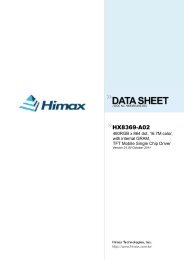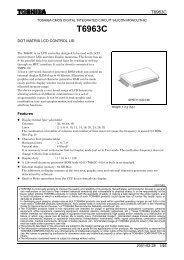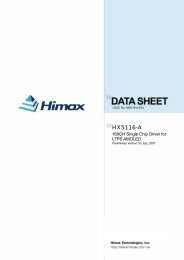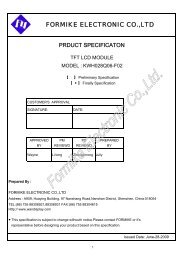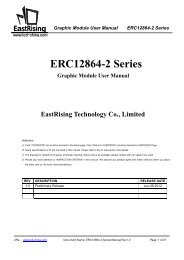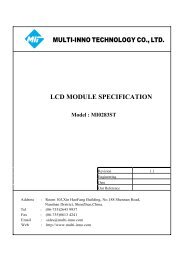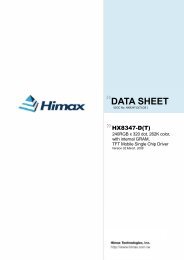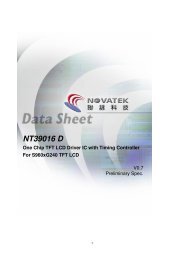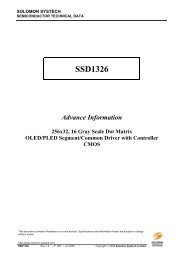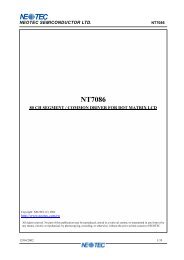MI160128AO - Display Future
MI160128AO - Display Future
MI160128AO - Display Future
You also want an ePaper? Increase the reach of your titles
YUMPU automatically turns print PDFs into web optimized ePapers that Google loves.
MULTI-INNO TECHNOLOGY CO., LTD.OLED MODULE SPECIFICATIONModel : <strong>MI160128AO</strong>Revision 1.0EngineeringDateOur Reference
MODULE NO.: <strong>MI160128AO</strong> Ver 1.0Revised HistoryPart Number Revision Revision Content Revised on<strong>MI160128AO</strong> 1.0 New Aug 01, 2006MULTI-INNO TECHNOLOGY CO.,LTD.P.2
MODULE NO.: <strong>MI160128AO</strong> Ver 1.0ContentsRevision History ................................................................................................... iNotice ................................................................................................................... iiContents .............................................................................................................. iii1. Basic Specifications .................................................................................. 1~51.1 <strong>Display</strong> Specifications .................................................................................................11.2 Mechanical Specifications ...........................................................................................11.3 Active Area & Pixel Construction ...............................................................................11.4 Mechanical Drawing....................................................................................................21.5 Pin Definition...............................................................................................................31.6 Block Diagram.............................................................................................................52. Absolute Maximum Ratings .......................................................................... 63. Electrical Characteristics......................................................................... 7~113.1 DC Characteristics .......................................................................................................73.2 AC Characteristics .......................................................................................................83.2.1 68XX-Series MPU Parallel Interface Timing Characteristics...........................83.2.2 80XX-Series MPU Parallel Interface Timing Characteristics...........................93.2.3 Serial Interface Timing Characteristics ...........................................................103.3 Optics & Electrical Characteristics............................................................................113.4 General Electrical Specification ................................................................................114. Functional Specification ....................................................................... 12~144.1 Commands .................................................................................................................124.2 Power down and Power up Sequence ........................................................................124.2.1 Power up Sequence..........................................................................................124.2.2 Power down Sequence .....................................................................................124.3 Reset Circuit...............................................................................................................124.4 Actual Application Example......................................................................................134.4.1 Driver IC Initial Setting Flowchart..................................................................134.4.2 Reference Parameters Table.............................................................................145. Reliability...................................................................................................... 155.1 Contents of Reliability Tests......................................................................................155.2 Lifetime......................................................................................................................155.3 Failure Check Standard..............................................................................................156. Outgoing Quality Control Specifications.............................................. 16~206.1 Environment Required...............................................................................................166.2 Sampling Plan ............................................................................................................166.3 Criteria & Acceptable Quality Level .........................................................................166.3.1 Cosmetic Check (<strong>Display</strong> Off) in Non-Active Area ........................................166.3.2 Cosmetic Check (<strong>Display</strong> Off) in Active Area.................................................196.3.3 Pattern Check (<strong>Display</strong> On) in Active Area.....................................................20MULTI-INNO TECHNOLOGY CO.,LTD.P.3
MODULE NO.: <strong>MI160128AO</strong> Ver 1.07. Package Specifications ................................................................................ 218. Precautions When Using These OEL <strong>Display</strong> Modules....................... 22~248.1 Handling Precautions.................................................................................................228.2 Storage Precautions....................................................................................................238.3 Designing Precautions ...............................................................................................238.4 Precautions when disposing of the OEL display modules.........................................238.5 Other Precautions.......................................................................................................23MULTI-INNO TECHNOLOGY CO.,LTD.P.4
MODULE NO.: <strong>MI160128AO</strong> Ver 1.01. Basic Specifications1.1 <strong>Display</strong> Specifications1) <strong>Display</strong> Mode: Passive Matrix2) <strong>Display</strong> Color: 262,144 Colors (Maximum)3) Drive Duty: 1/128 Duty1.2 Mechanical Specifications1) Outline Drawing: According to the annexed outline drawing number2) Number of Pixels: 160 (RGB) × 1283) Panel Size: 39.90 × 34.00 × 1.70 (mm)4) Active Area: 33.575 × 26.864 (mm)5) Pixel Pitch: 0.07 × 0.21(mm)6) Pixel Size: 0.045 × 0.194 (mm)7) Weight: 4.5 (g)1.3 Active Area & Pixel ConstructionS0( Column 1 )G127( Row 128 )G1( Row 2 )S479( Column 480 )G126( Row 127 )G0( Row 1 )0.210.1850.070.0450.210.194R G BMULTI-INNO TECHNOLOGY CO.,LTD.P.5
MODULE NO.: <strong>MI160128AO</strong> Ver 1.01.4 Mechanical DrawingS0( Column 1 )PinG127( Row 128 )G1( Row 2 )124 35678111213141516171819202122232425262728293031323334S479( Column 480 )G126( Row 127 )G0( Row 1 )SymbolNCVSDHVDDHVSSHIREFOSCA2OSCA1VDDIO10 9 VSYNCOVSYNCHSYNCDOTCLKENABLECPUPSD17D16D15D14D13D12D11D10D9RSCSBRDBWRBRESETBVSSVDDVSSHVDDHVSDH35 NC0.210.1850.070.045R G B0.1940.21Detail "A" (20:1)<strong>Display</strong> Pattern(5)(1.7)(8.93)(12.43)(1.7)(1.5)3 (Stiffener)0.5±0.5 82-?1±0.05105Polarizert=0.2mmContact SideProtective Film30mm x 10mmGlue0.10.3±0.0339.9±0.2 (Panel Size)39.9±0.2 (Cap Size)38.9 (Polarizer)0.8 Max35.575 (View Area)P0.07x(160x3)-0.025=33.575 (Active Area)0.5±0.5(2.162)(3.162)(2.1)(1.1)0.5±0.5"A"Active Area 1.69"160(RGB) x 128 PixelsP0.18x128-0.016=26.864 (Active Area)28.864 (View Area)31 (Polarizer)32±0.2 (Cap Size)34±0.2 (Panel Size)4.59.510.514.5±0.2R0.2VSSVDDVSSHVDDHVSDHNCRESETBWRBRSCSBRDBD17D16D15D14D13D12D11D10D9NCVSDHVDDHVSSHIREFOSCA2OSCA1VDDIOVSYNCOVSYNCHSYNCDOTCLKENABLECPUPS1 35W=0.35±0.03P0.5x(35-1)=17±0.0518±0.230.68±0.1 (Alignment Hole)32.68±0.22.85Notes:1. Driver IC: SEPS5252. Die Size: 19660um x 1850um3. COF Number: SEPS525-F004. Interface:6-/8-/9-/ bit 68XX/80XX Parallel, 6bit-RGB I/F , 4-wire SPI5. General Tolerance: ±0.306. The total thickness (1.70 Max) is without Polarizer protective film & Remove Tape.The actual assembled total thickness with above materials should be 1.85 MaxMULTI-INNO TECHNOLOGY CO.,LTD.P.6
MODULE NO.: <strong>MI160128AO</strong>Ver1.01.5 Pin DefinitionPin Number Symbol Type FunctionPower Supply Pins2,34 VSDH P Data Driver Ground4,32 VSSH P Scan Driver Ground3,33 VDDH P Data, Scan Driver Power Supply.30 VSS P Logic Ground31 VDD. P Logic Power Supply.8 VDDIO P MPU I/F PAD Power SupplySystem Control Pins5 IREF I6 OSCA2 O7 OSCA1 I14 CPU I15 PS IMPU Interface Pins9 VSYNCO O10 VSYNC I11 HSYNC I12 DOTCLK I13 ENABLE I16~24 D17~D9 I/O25 RS I26 CSB I27 RDB ICurrent Reference for Brightness AdjustmentTie 68KΩ resistor to VSS.Fine adjustment for oscillationTie 10 KΩ resistor to OSCA1 between OSCA2.When the external clock mode is selected, OSCA1 is usedexternal clock input.elects the CPU typeLow: 80-series CPU, High: 68-Series CPU.Selects parallel/Serial interface typeLow: serial, High: parallel.RGB Mode Functional PinsVSYNCO: Vertical Sync. OutputVSYNC: Vertical Sync. InputHSYNC: Horizontal Sync. InputDOTCLK: Dot Clock InputENABLE: Video Enable InputHost Data Input/Output BusThese pins are 9-bit bi-directional data bus to beconnected with MCU data bus.PSDescription8_bit bus : D[17:10]19_bit bus : D[17:9]D[17] SCL : Synchronous clock input0 D[16] SDI : Serial data inputD[15] SDO : Serial data outputFix unused pins to the VSS level.Selects the data/commandLow: command, High: parameter/dataChip SelectLow: SEPS525 is selected and can be accessed.High: SEPS525 is not selected and cannot be accessed.Read or Read/Write Enable80-system bus interface: read strobe signal (active low).68-system bus interface: bus enable strobe (active high).When serial mode, fix it to VDD or VSS level.MULTI-INNO TECHNOLOGY CO.,LTD.P.7
MODULE NO.: <strong>MI160128AO</strong> Ver 1.01.5 Pin Definition (Continued)Pin Number Symbol Type FunctionMPU Interface Pins (Continued)28 WRB I29 RESETB IReserved Pins1,35 NC - No ConnectionWrite or Read/Write Select80-system bus interface: write strobe signal (active low).68-system bus interface: read/write select.Low: write, High: read.When serial mode, fix it to VDD or VSS level.Chip ResetReset SEPS525 (active low)MULTI-INNO TECHNOLOGY CO.,LTD.P.8
MODULE NO.: <strong>MI160128AO</strong> Ver 1.01.6 Block DiagramActive Area 1.69"160 (RGB) x 128 PixelsG1G127S0SEPS525S479G126G0NCVSDHVDDHVSSHIREFOSCA2OSCA1VDDIOVSYNCOVSYNCHSYNCDOTCLKENABLECPUPSD17~D9RSCSBRDBWRBRESETBVSSVDDVSSHVDDHVSDHNCR1C3R2 C1 C2VDDHVDDIOVDDMCU Interface Selection: PS, CPUPins connected to MCU interface: D17~D9, RS, CSB, RDB, WRB, RESETB,ENABLE, DOTCLK, HSYNC, and VSYNC* When RGB mode is used, D[17:12], ENABLE, DOTCLK, HSYNC, and VSYNCshould follow the 6-bit RGB interface instruction. Otherwise, ENABLE,DOTCLK, HSYNC, and VSYNC these four input signal should be tie to VSSlevel, and VSYNCO should be floating.C1: 1μFC2, C3: 4.7μFR1: 10kΩR2: 68kΩMULTI-INNO TECHNOLOGY CO.,LTD.P.9
MODULE NO.: <strong>MI160128AO</strong> Ver 1.02.Absolute Maximum RatingsParameter Symbol Min Max Unit NotesSupply Voltage VDD -0.3 4 V 1, 2Supply Voltage for I/O Pins VDDIO -0.3 4 V 1, 2Driver Supply Voltage VDDH -0.3 19.5 V 1, 2Operating Temperature T OP -30 70 °C -Storage Temperature T STG -40 80 °C -Note 1: All the above voltages are on the basis of “GND = 0V”.Note 2: When this module is used beyond the above absolute maximum ratings,permanent breakage of the module may occur. Also, for normal operations,it is desirable to use this module under the conditions according to Section 3.“Electrical Characteristics”. If this module is used beyond these conditions,malfunctioning of the module can occur and the reliability of the module maydeteriorate.MULTI-INNO TECHNOLOGY CO.,LTD.P.10
MODULE NO.: <strong>MI160128AO</strong> Ver 1.03. Electrical Characteristics3.1 DC CharacteristicsCharacteristics Symbol Conditions Min Typ Max UnitSupply Voltage VDD 2.6 2.8 3.3 VSupply Voltage for I/O Pins VDDIO 1.6 2.8 3.3 VDriver Supply Voltage VDDH 13.5 14.0 14.5 VHigh Level Input V IH 0.8×VDD - VDD VLow Level Input V IL 0 - 0.4 VHigh Level Output V OH VDD-0.4 - - VLow Level Output V OL - - 0.4 VMULTI-INNO TECHNOLOGY CO.,LTD.P.11
MODULE NO.: <strong>MI160128AO</strong> Ver 1.03.2 AC Characteristics3.2.1 68XX-Series MPU Parallel Interface Timing Characteristics:(VDD = 2.8V, Ta = 25℃)Item Symbol Condition Min Max Unit PortWrite TimingAddress hold timingAddress setup timingSystem cycle timingWrite “L” pulse widthWrite “H” pulse widthData setup timingData hold TimingRead TimingAddress hold timingAddress setup timingSystem cycle timingRead “L” pulse widthRead “H” pulse widthRead data output delay timeData hold Timingt AH6t AS6t CYC6t ELW6t EHW6t DS6t DH6t AH6t AS6t CYC6t ELR6*) All the timing reference is 10% and 90% of VDD.--5510045454010- nsCSBRS- ns E- ns DB[17:0]-10CSB- ns10RS200- 90 - ns Et EHR690t RDD6t RDH6C L = 15pF 0 70 ns DB[17:0]MULTI-INNO TECHNOLOGY CO.,LTD.P.12
MODULE NO.: <strong>MI160128AO</strong> Ver 1.03.2.2 80XX-Series MPU Parallel Interface Timing Characteristics:(VDD = 2.8V, Ta = 25℃)Item Symbol Condition Min Max Unit PortWrite TimingAddress hold timingAddress setup timingSystem cycle timingWrite “L” pulse widthWrite “H” pulse widthData setup timingData hold TimingRead TimingAddress hold timingAddress setup timingSystem cycle timingRead “L” pulse widthRead “H” pulse widthRead data output delay timeData hold Timingt AH8t AS8t CYC8t WRLW8 -t WRHW8t DS8t DH8t AH8t AS8t CYC8t RDLR8t RDHR8t RDD8Ct L = 15pFRDH8*) All the timing reference is 10% and 90% of VDD.---551004545301010102009090-0- nsCSBRS- ns WRB- ns DB[17:0]- nsCSBRS- ns RDB60 ns DB[17:0]MULTI-INNO TECHNOLOGY CO.,LTD.P.13
MODULE NO.: <strong>MI160128AO</strong> Ver 1.03.2.3 Serial Interface Timing Characteristics:(VDD = 2.8V, Ta = 25℃)Item Symbol Condition Min Max Unit PortSerial clock cycleSCL “H” pulse widtht CYCSt SHW -6025 - ns SCLSCL “L” pulse width t SLW25Data setup timingt DSS-25- ns SDIData hold TimingCSB-SCL timingCSB-hold timingt DHSt CSSt CSH*) All the timing reference is 10% and 90% of VDD.252525- ns CSBMULTI-INNO TECHNOLOGY CO.,LTD.P.14
MODULE NO.: <strong>MI160128AO</strong> Ver 1.03.3 Optics & Electrical CharacteristicsCharacteristics Symbol Conditions Min Typ Max UnitBrightness (White) L br Note 3 70 100 - cd/m 2C.I.E. (White)(x)0.22 0.26 0.30Note 3(y)0.24 0.28 0.32C.I.E. (Red)(x)0.61 0.65 0.69Note 3(y)0.30 0.34 0.38C.I.E. (Green)(x)0.26 0.30 0.34Note 3(y)0.58 0.62 0.66C.I.E. (Blue)(x)0.10 0.14 0.18Note 3(y)0.15 0.19 0.23Dark Room Contrast CR - >1000:1 -View Angle >160 - - degreeNote3: Optical measurement with polarizer is taken @ VDD, VDDIO = 2.8V,VDDH = 14V, and the software initial setting with section 4.4.2 ReferenceParameter Table for Normal Operation Mode.3.4 General Electrical SpecificationCharacteristics Symbol Conditions Min Typ Max UnitSupply Voltage VDD 2.4 2.8 3.3 VSupply Voltage forI/O PinsVDDIO 1.6 2.8 3.3 VDriver Supply Voltage VDDH 13.5 14.0 14.5 VOperating Current forVDDI VDDNote 4 - 2.5 3.5 mANote 5 - 2.5 3.5 mAOperating Current forNote 4 - 25 31 mAIVDDHVDDHNote 5 - 8 10 mASleep Mode Current for I VDD,- 1 5 μAVDDSLEEPSleep Mode Current for I VDDH,- 1 5 μAVDDHSLEEPNote 4: VDD & VDDIO = 2.8V, VDDH = 14V, L br @ 100cd/m 2 , full white withpolarizer, software initial setting follow section 4.4.2 Reference ParameterTable for Normal Operation Mode.Note 5: VDD & VDDIO = 2.8V, VDDH = 14V, L br @ 30cd/m 2 , full white withpolarizer, software initial setting follow section 4.4.2 Reference ParameterTable for Power Saving Mode.MULTI-INNO TECHNOLOGY CO.,LTD.P.15
MODULE NO.: <strong>MI160128AO</strong> Ver 1.04. Functional Specification4.1. CommandsRefer to the Technical Manual for the SEPS5254.2 Power down and Power up SequenceTo protect OEL panel and extend the panel life time, the driver IC power up/downroutine should include a delay period between high voltage and low voltage powersources during turn on/off. It gives the OEL panel enough time to complete theaction of charge and discharge before/after the operation.4.2.1 Power up Sequence:1. Power up VDD, VDDIO2. Send <strong>Display</strong> off command3. Clear Screen4. Power up VDDH5. Delay 100ms(when VDD is stable)6. Send <strong>Display</strong> on commandVDDHVDDVDDIOGroundVDD, VDDIO onVDDH on<strong>Display</strong> on4.2.2 Power down Sequence:1. Send <strong>Display</strong> off command2. Power down VDDH3. Delay 100ms(when VDDH is reach 0 andpanel is completely discharges)4. Power down VDD, VDDIOVDDHVDDVDDIOGround<strong>Display</strong> offVDDH offVDD, VDDIO off4.3 Reset CircuitWhen RESETB input is low, the chip is initialized with the following status:1. Frame frequency: 90Hz2. OSC: internal OSC3. Internal OSC: ON4. DDRAM write horizontal address: MX1 = 00h, MX2 = 9Fh5. DDRAM write vertical address: MY1 = 00h, MY2 = 7Fh6. <strong>Display</strong> data RAM write: HC = 1, VC = 1, HV = 07. RGB data swap: OFF8. Row scan shift direction: G0, G1, … , G126, G1279. Column data shift direction: S0, S1, … , S478, S47910. <strong>Display</strong> ON/OFF: OFF11. Panel display size: FX1 = 00h, FX2 = 9Fh, FY1 = 00h, FY2 = 7Fh12. <strong>Display</strong> data RAM read column/row address: FAC = 00h, FAR = 00h13. Precharge time(R/G/B): 0 clock14. Precharge current(R/G/B): 0 uA15. Driving current(R/G/B): 0 uAMULTI-INNO TECHNOLOGY CO.,LTD.P.16
MODULE NO.: <strong>MI160128AO</strong> Ver 1.04.4 Actual Application Example4.4.1 Driver IC Initial Setting FlowchartSet DISP_OFFSetDRIVING_CURRENT_GSet DUTYSet SOFT_RETSetDRIVING_CURRENT_BSet DSLSet REDUCE_CURRENTSetDISPLAY_MODE_SETSet D1_DDRAM_FACSet OSC_CTLSet RGB_IFSet D1_DDRAM_FARSet CLOCK_DIVSet RGB_POLSet D1_DDRAM_SACSetPRECHARGE_TIME_RSet MEMORY_WRITE_MODESet D1_DDRAM_SARSetPRECHARGE_TIME_RSet MX1_ADDRSet SCR1_FX1SetPRECHARGE_TIME_RSet MX2_ADDRSet SCR1_FX2Set PRECHARGE_CURRENT_RSet MY1_ADDRSet SCR1_FY1Set PRECHARGE_CURRENT_GSet MY2_ADDRSet SCR1_FY2Set PRECHARGE_CURRENT_BSet MEMORY_ACCESS_POINTER XSet IREFSetDRIVING_CURRENT_RSet MEMORY_ACCESS_POINTER YSet DISP_ONMULTI-INNO TECHNOLOGY CO.,LTD.P.17
MODULE NO.: <strong>MI160128AO</strong> Ver 1.04.4.2 Reference Parameters TableCommand Parameter(VDD = 2.8V, Ta = 25℃)NormalOperationModePower SavingModeSet <strong>Display</strong> On_OFF0x06 , 0x00Set SOFT_RST0x05 , 0x00Set REDUCE_CURRENT0x04 , 0x01 wait 1ms 0x04,0x00Set OSC_CTL0x02 , 0x01Set CLOCK_DIV0x03 , 0x09Set PRECHARGE_TIME_R 0x08 , 0x03 0x08 , 0x00Set PRECHARGE_TIME_G 0x09 , 0x05 0x09 , 0x00Set PRECHARGE_TIME_B 0x0A , 0x05 0x0A , 0x00Set PRECHARGE_CURRENT_R 0x0B , 0x56 0x0B , 0x00Set PRECHARGE_CURRENT_G 0x0C , 0x4D 0x0C , 0x00Set PRECHARGE_CURRENT_B 0x0D , 0x46 0x0D , 0x00Set DRIVING_CURRENT_R 0x10 , 0x0A 0x10 , 0x0DSet DRIVING_CURRENT_G 0x11 , 0x0A 0x11 , 0x0CSet DRIVING_CURRENT_B 0x12 , 0x0A 0x12 , 0x0BSet DISPLAY_MODE_SET0x13 , 0x00Set RGB_IF0x14 , 0x01Set RGB_POL0x15 , 0x00Set MEMORY_WRITE_MODE0x16 , 0x76Set MX1_ADDR0x17 , 0x00Set MX2_ADDR0x18 , 0x9FSet MY1_ADDR0x19 , 0x00Set MY2_ADDR0x1A , 0x7FSet MEMORY_ACCESS_POINTER X0x20 , 0x00Set MEMORY_ACCESS_POINTER Y 0x21 ,0x00Set DUTY0x28 , 0x7FSet DSL0x29 , 0x00Set D1_DDRAM_FAC0x2E , 0x00Set D1_DDRAM_FAR0x2F , 0x00Set D1_DDRAM_SAC0x31 , 0x00Set D1_DDRAM_SAR0x32 , 0x00Set SCR1_FX10x33 , 0x00Set SCR1_FX20x34 , 0x9FSet SCR1_FY10x35 , 0x00Set SCR1_FY20x36 , 0x7FSet IREF0x80 , 0x00Set DISP_ON_OFF0x06 , 0x01MULTI-INNO TECHNOLOGY CO.,LTD.P.18
MODULE NO.: <strong>MI160128AO</strong> Ver 1.05. Reliability5.1 Contents of Reliability TestsHigh Temperature OperationLow Temperature OperationHigh Temperature StorageLow Temperature StorageHigh Temperature/HumidityOperationThermal ShockItem Conditions Criteria70°C, 240 hrs-30°C, 240 hrs80°C, 240 hrs-40°C, 240 hrs60°C, 90% RH, 120 hrs-40°C ⇔ 85°C, 24 cycles1 hr dwell* The samples used for the above tests do not include polarizer.* No moisture condensation is observed during tests.The operationalfunctions work.5.2 LifetimeEnd of lifetime is specified as 50% of initial brightness.Parameter Min Max Unit Condition NotesOperating Life Time 10,000 - Hrs 70 cd/m , 50%checkerboard 6Storage Life Time 20,000 - Hrs Ta=25°C, 50%RH -Note 6: The average operating lifetime at room temperature is estimated by theaccelerated operation at high temperature conditions.5.3 Failure Check StandardAfter the completion of the described reliability test, the samples were left at roomtemperature for 2 hrs prior to conducting the failure test at 23±5°C; 55±15% RH.MULTI-INNO TECHNOLOGY CO.,LTD.P.19
MODULE NO.: <strong>MI160128AO</strong> Ver 1.06. Outgoing Quality Control Specifications6.1 Environment RequiredCustomer’s test & measurement are required to be conducted under the followingconditions:Temperature: 23 ± 5°CHumidity:55 ± 15 %RHFluorescent Lamp:30WDistance between the Panel & Lamp:≥ 50 cmDistance between the Panel & Eyes of the Inspector: ≥ 30 cmFinger glove (or finger cover) must be worn by the inspector.Inspection table or jig must be anti-electrostatic.6.2 Sampling PlanLevel II, Normal Inspection, Single Sampling, MIL-STD-105E6.3 Criteria & Acceptable Quality LevelPartition AQL DefinitionMajor 0.65 Defects in Pattern Check (<strong>Display</strong> On)Minor 1.0 Defects in Cosmetic Check (<strong>Display</strong> Off)6.3.1 Cosmetic Check (<strong>Display</strong> Off) in Non-Active AreaCheck Item Classification CriteriaX > 6 mmY > 1 mm(Along with Edge)(Perpendicular to edge)XPanelGeneral ChippingMinorYXYMULTI-INNO TECHNOLOGY CO.,LTD.P.20
MODULE NO.: <strong>MI160128AO</strong> Ver 1.06.3.1 Cosmetic Check (<strong>Display</strong> Off) in Non-Active Area (Continued)Check Item Classification CriteriaAny crack is not allowable.Panel CrackMinorCupper Exposed(Even Pin or Film)MinorNot Allowable by Naked EyeInspectionFilm or Trace DamageMinorNot AllowableTerminal Lead TwistMinorNot AllowableTerminal Lead BrokenMinorTerminal Lead ProbeMarkAcceptableOkMULTI-INNO TECHNOLOGY CO.,LTD.P.21
MODULE NO.: <strong>MI160128AO</strong> Ver 1.06.3.1 Cosmetic Check (<strong>Display</strong> Off) in Non-Active Area (Continued)Check Item Classification CriteriaNG if any bent lead cause leadshorting.MinorTerminal Lead Bent(Not Twist or Broken)NG for horizontally bent lead morethan 50% of its width.MinorGlue or Contaminationon Pin(Couldn’t Be Removedby Alcohol)MinorInk Marking on BackSide of panel(Exclude on Film)AcceptableIgnore for AnyMULTI-INNO TECHNOLOGY CO.,LTD.P.22
MODULE NO.: <strong>MI160128AO</strong> Ver 1.06.3.2 Cosmetic Check (<strong>Display</strong> Off) in Active AreaIt is recommended to execute in clear room environment (class 10k) if actualin necessary.Check Item Classification CriteriaAny Dirt & Scratch onProtective FilmAcceptable Ignore for AnyScratches, Fiber, Line-ShapeDefect(On Polarizer)Dirt, Spot-Shape Defect(On Polarizer)Dent, Bubbles, White spot(Any Transparent Spot onMinorW ≤ 0.1IgnoreMinor W ≤ 0.1 IgnoreW > 0.1, L ≤ 2 n ≤ 1L > 2 n = 0Φ ≤ 0.1 IgnoreMinor 0.1
MODULE NO.: <strong>MI160128AO</strong> Ver 1.06.3.3 Pattern Check (<strong>Display</strong> On) in Active AreaCheck Item Classification CriteriaNo <strong>Display</strong> Major Not allowableBright LineMajorMissed LineMajorPixel ShortMajorDarker PixelMajorWrong <strong>Display</strong>MajorUn-Uniform (LuminanceVariation within a <strong>Display</strong>)MajorMULTI-INNO TECHNOLOGY CO.,LTD.P.24
MODULE NO.: <strong>MI160128AO</strong> Ver 1.07. Package SpecificationsEPE COVER FOAM 351x212x1,ANTISTATIC x 1 Pcsx 1 pcs (Empty)16 Pcs Tray Vacuum packingModulex 15 pcsStaggered StackingEPE PROTECTTIVETray 420x285 T=0.8mmExsiccator x 2 pcsWrapped with adhesive tapex 16 pcsBrimary Box 4 SETVacuum packing bagEPE PROTECTTIVE370mm x 280mm x 20mmCARTON BOXPrimary L450mm x W296 x H110, B wavex 4PcsLabelCarton Box L464mm x W313mm x H472mm, AB waveMULTI-INNO TECHNOLOGY CO.,LTD.P.25
MODULE NO.: <strong>MI160128AO</strong> Ver 1.08. Precautions When Using These OEL <strong>Display</strong> Modules8.1 Handling Precautions1) Since the display panel is being made of glass, do not apply mechanical impactssuch us dropping from a high position.2) If the display panel is broken by some accident and the internal organicsubstance leaks out, be careful not to inhale nor lick the organic substance.3) If pressure is applied to the display area, both of top and back sides, or itsneighborhood of the OEL display module, the cell structure may be damagedand be careful not to touch these sections on carrying and assembly.4) The polarizer covering the surface of the OEL display module is soft and easilyscratched. Please be careful when handling the OEL display module.5) When the surface of the polarizer of the OEL display module has soil, clean thesurface. It takes advantage of by using following adhesion tape.* Scotch Mending Tape No. 810 or an equivalentNever try to breathe upon the soiled surface nor wipe the surface using clothcontaining solvent such as ethyl alcohol, since the surface of the polarizer willbecome cloudy.Also, pay attention that the following liquid and solvent may spoil the polarizer:* Water* Ketone* Aromatic Solvents6) When installing the OEL display module, be careful not to apply twisting stressor deflection stress to the OEL display module. And, do not over bend thefilm with electrode pattern layouts. These stresses will influence the displayperformance. Also, secure sufficient rigidity for the outer cases.7) Do not apply stress to the LSI chips and the surrounding molded sections.8) Do not disassemble nor modify the OEL display module.9) Do not apply input signals while the logic power is off.10) Pay sufficient attention to the working environments when handing OELdisplay modules to prevent occurrence of element breakage accidents by staticelectricity.* Be sure to make human body grounding when handling OEL displaymodules.* Be sure to ground tools to use or assembly such as soldering irons.* To suppress generation of static electricity, avoid carrying out assembly workunder dry environments.* Protective film is being applied to the surface of the display panel of the OELdisplay module. Be careful since static electricity may be generated whenexfoliating the protective film.11) Protection film is being applied to the surface of the display panel and removesthe protection film before assembling it. At this time, if the OEL displaymodule has been stored for a long period of time, residue adhesive material ofthe protection film may remain on the surface of the display panel afterremoved of the film. In such case, remove the residue material by the methodintroduced in the above Section 5).12) If electric current is applied when the OEL display module is being dewed orwhen it is placed under high humidity environments, the electrodes may becorroded and be careful to avoid the above.MULTI-INNO TECHNOLOGY CO.,LTD.P.26
MODULE NO.: <strong>MI160128AO</strong> Ver 1.08.2 Storage Precautions1) When storing OEL display modules, put them in static electricity preventivebags avoiding exposure to direct sun light nor to lights of fluorescent lamps, etc.and, also, avoiding high temperature and high humidity environments or lowtemperature (less than 0°C) environments. (We recommend you to store thesemodules in the packaged state when they were shipped from Multi-InnoTechnology Co.,Ltd.)At that time, be careful not to let water drops adhere to the packages or bags norlet dewing occur with them.2) If electric current is applied when water drops are adhering to the surface of theOEL display module, when the OEL display module is being dewed or when itis placed under high humidity environments, the electrodes may be corrodedand be careful about the above.8.3 Designing Precautions1) The absolute maximum ratings are the ratings which cannot be exceeded forOEL display module, and if these values are exceeded, panel damage may behappen.2) To prevent occurrence of malfunctioning by noise, pay attention to satisfy theVIL and VIH specifications and, at the same time, to make the signal line cableas short as possible.3) We recommend you to install excess current preventive unit (fuses, etc.) to thepower circuit (VDD). (Recommend value: 0.5A)4) Pay sufficient attention to avoid occurrence of mutual noise interference withthe neighboring devices.5) As for EMI, take necessary measures on the equipment side basically.6) When fastening the OEL display module, fasten the external plastic housingsection.7) If power supply to the OEL display module is forcibly shut down by such errorsas taking out the main battery while the OEL display panel is in operation, wecannot guarantee the quality of this OEL display module.8) The electric potential to be connected to the rear face of the IC chip should beas follows: SSPS525* Connection (contact) to any other potential than the above may lead torupture of the IC.8.4 Precautions when disposing of the OEL display modules1) Request the qualified companies to handle industrial wastes when disposing ofthe OEL display modules. Or, when burning them, be sure to observe theenvironmental and hygienic laws and regulations.8.5 Other Precautions1) When an OEL display module is operated for a long of time with fixed patternmay remain as an after image or slight contrast deviation may occur.Nonetheless, if the operation is interrupted and left unused for a while, normalMULTI-INNO TECHNOLOGY CO.,LTD.P.27
MODULE NO.: <strong>MI160128AO</strong> Ver 1.0state can be restored. Also, there will be no problem in the reliability of themodule.2) To protect OEL display modules from performance drops by static electricityrapture, etc., do not touch the following sections whenever possible whilehandling the OEL display modules.* Pins and electrodes* Pattern layouts such as the COF3) With this OEL display module, the OEL driver is being exposed. Generallyspeaking, semiconductor elements change their characteristics when light isradiated according to the principle of the solar battery. Consequently, if thisOEL driver is exposed to light, malfunctioning may occur.* Design the product and installation method so that the OEL driver may beshielded from light in actual usage.* Design the product and installation method so that the OEL driver may beshielded from light during the inspection processes.4) Although this OEL display module stores the operation state data by thecommands and the indication data, when excessive external noise, etc. entersinto the module, the internal status may be changed. It therefore is necessaryto take appropriate measures to suppress noise generation or to protect frominfluences of noise on the system design.5) We recommend you to construct its software to make periodical refreshment ofthe operation statuses (re-setting of the commands and re-transference of thedisplay data) to cope with catastrophic noise.MULTI-INNO TECHNOLOGY CO.,LTD.P.28




